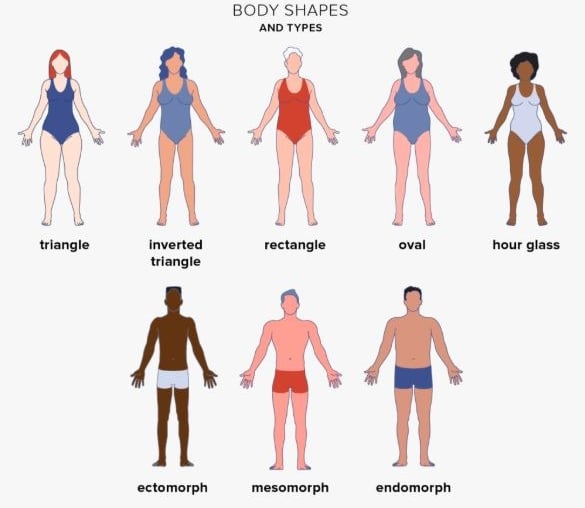Body Types
8/7/20252 min read


Understanding Body Types: More Than Just Shapes
You might have heard terms like ectomorph, mesomorph, endomorph, and body shapes like hourglass or triangle. But what do they really mean—and why should they matter?
What Is a "Body Type"?
According to Medical News Today, body type refers to a person’s skeletal frame and body composition—how lean they are or how they store fat—usually solidified after puberty but subject to change through lifestyle and hormonal shifts.
The Three Classic Somatotypes
The three traditional body types—ectomorph, mesomorph, and endomorph—come from psychologist William H. Sheldon’s 1940s research:
Ectomorphs: Lean and slender, with low fat and muscle mass. They often have higher metabolisms and may find it tough to gain weight or build muscle. Think models like Kate Moss or actors like Brad Pitt.
Mesomorphs: Naturally athletic with well-distributed muscle. They gain or lose weight relatively easily and typically respond well to resistance training.
Endomorphs: Typically rounder with a tendency to store fat more easily. They may have a slower metabolism and require targeted strategies for weight management. Celebrities like Jennifer Lopez or Beyoncé are often examples.
The Real World? It’s Often a Mix.
Most people don’t fit neatly into one category—they’re hybrids like ecto-mesomorphs or endo-ectomorphs. For instance, an ecto-endomorph might carry more fat on their lower body (pear-shaped), while endo-ectomorphs may store fat in the upper body (apple-shaped).
Why It Matters—But Not Too Much
Understanding your body type can guide fitness and nutrition choices. For example:
Ectomorphs benefit from resistance training and higher-calorie diets to support muscle growth.
Mesomorphs thrive on balanced workout plans—combining strength training and cardio.
Endomorphs may find more success with a combination of aerobic exercise and calorie-conscious eating.
Yet, experts caution against letting body type define your potential. Dr. Geary, a sports medicine specialist, emphasizes that while genetics are a factor, all body types benefit from staying active—and body type shouldn’t limit your health or fitness journey.
Body Shape vs. Body Type: Is There a Health Angle?
Body shape—think hourglass, pear, apple, or rectangle—is more about fat distribution and curves.
While not inherently unhealthy, certain shapes—like the apple shape—may carry higher risks for heart disease, diabetes, and colorectal cancer, largely due to visceral fat accumulation around the abdomen.
Medical experts advise that waist-to-hip ratio is often a better health indicator than BMI alone, especially for assessing internal fat-related risks.
Wrapping It Up
Understanding if you're more ectomorphic, mesomorphic, or endomorphic can help tailor your workouts or nutrition—but don't box yourself in. You're a unique combination of traits and habits, and many parts of your body’s appearance are adaptable.
Embrace your shape, stay active, and focus on habits that support long‑term health—not just the label of a body type.